Search Results
US Senator Alex Padilla and San Francisco Mayor London Breed tour BART’s Powell Street Station as Transit Ridership Rebounds
On April 12, 2022 U.S Senator Alex Padilla (D.-Calif.) and San Francisco Mayor London Breed joined leaders from BART and San Francisco Municipal Transportation Agency (SFMTA) at Powell Street Station to see firsthand the benefits of American Rescue Plan emergency funds and the potential for upcoming
Position open on BART Police Citizen Review Board – District 5 (Accepting applications until 08/08/24)
BART will be accepting applications for membership on the BART Police Citizen Review Board (BPCRB) from Monday, July 8, 2024 - Thursday, August 8, 2024. This appointment will be made by BART Director Melissa Hernandez, District 5.
As a volunteer of the BPCRB, members work to increase the public's confidence in BART's policing services by:
- Reviewing, recommending, and monitoring the implementation of changes to police policies, procedures, and practices
- Receiving citizen allegations of on-duty police misconduct
- Advising Board of Directors, General Manager, Independent Police Auditor, and Police Chief
- Participating in recommending appropriate disciplinary action
- Meeting periodically with representatives of the BART Police associations
- Participating in community outreach
Member Qualifications
Members must:
- Reside within Alameda, Contra Costa, San Francisco, or San Mateo counties
- Be fair-minded and objective
- Have demonstrated commitment to community service
- Not be currently employed in a law enforcement capacity, either sworn or non-sworn
- Not be a relative of current or former BART Police Department personnel
- Have no felony convictions
Duration of Service
All appointments to the BPCRB are for a term of two years. There are no term limits.
How to Apply
To learn more about the BPCRB and/or how to apply for appointment, visit our website at bart.gov/about/bod/advisory/crb. Access the digital application here and the print application below.
Please send an email to [email protected] or call (510) 464-6083 with any questions.
Application period closes on Thursday, August 8, 2024
Documents
BPCRB Recruitment Flyer (.doc)
Application for BPCRB - District 5 (.doc)
BPCRB General Information (.doc)
Engineers Week 2025: BART engineers on the year’s big projects and why they’re proud to be a part of them

Every year, BART celebrates Engineers Week in recognition of the more than 180 engineers who are committed to imagining and executing the future of the BART system. BART is the Bay Area, and the future of our transportation system is deeply entwined with the future of this region. Our engineers provide us a roadmap for the fast-approaching horizon, reshaping how we experience and interact with our world.
BART is unique in that it’s home to many different engineering disciplines – construction, computer systems, electrical, mechanical, traction power, corrosion, and more! The projects our engineers undertake are like puzzles with hundreds of thousands of pieces, all of which must fit together just right to make a functioning whole. Our engineers’ ingenuity, creativity, and resourcefulness get this tough work done.
The theme of Engineers Week 2025 is Design Your Future – “both a call to action and a celebration of the limitless possibilities in engineering,” writes DiscoverE, which established Engineers Week more than 70 years ago. How far we’ve come!
In 2025, BART engineers are not just “designing” the future, but implementing it. It’s going to be a big year for BART, and so we reached out to the engineers themselves to tell you about some of the exciting projects BART has in store for 2025 and why they’re proud to be a part of it.
And speaking of the future – we're now looking for our 2025 class of engineering interns! Since 2018, BART has hired 15 internship participants as junior engineers, including four from last year’s program – it's a great way to get your foot in the door and gain hands-on, practical engineering experience.
Visit bart.gov/internships for information on eligibility and how to apply.
Next-Generation Fare Gates Project
BART has made the historic purchase of brand-new fare gates to be installed systemwide as part of its latest effort to improve the customer experience and overhaul safety in the system. The new fare gates bring a new look and improved experience, offering state-of-the-art technology that will boost safety by reducing fare evasion, enhancing access for people in wheelchairs and those who bring bikes and strollers on BART, and optimizing the reliability and maintenance needs of the fare gates.
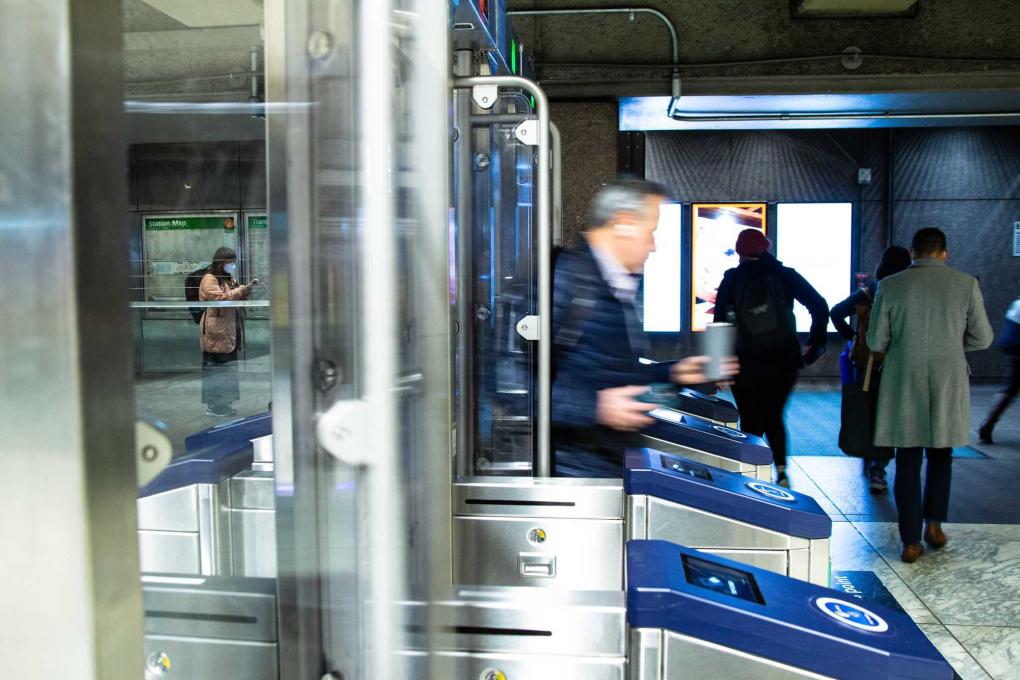
A photo of the new fare gates at Embarcadero Station.
Michael Gerbracht, Senior Manager of Engineering Programs
"Creating an environment where passengers feel safe, comfortable, and are happy to ride our trains is crucial. The fare gates are something that riders from across the Bay Area have been excited to see implemented for years, and it is great to be able to deliver for them.
I am so proud of the way the team – and really the entire District - has stepped up to the challenge of delivering the new fare gates."
John Yen, Manager of Computer Systems Engineering
"The part I am personally proud of is our staff’s ability to stay flexible and adapt to changing project conditions and project complexity. There are a lot of varying site conditions and prep work by multiple disciplines (electrical, communications, buildings, etc.) before the new fare gates can be installed. This project effectively is rolling three projects into one!"
San Francisco Station Escalator and Canopy Project
The San Francisco Station Canopy Project will not only protect new escalators being installed from the wear-and-tear of elements like rain and wind-swept debris, but they will provide an added layer of station security and cleanliness through motorized gates that allow the entrances to be locked at street level when stations are closed. At present, 14 canopies have been completed, and three canopies are under construction, with an additional four canopies to be constructed in the future. The project is happening in concurrence with the San Francisco Station Escalator Replacement Project, which is installing and replacing a total of 45 escalators at Downtown San Francisco stations.
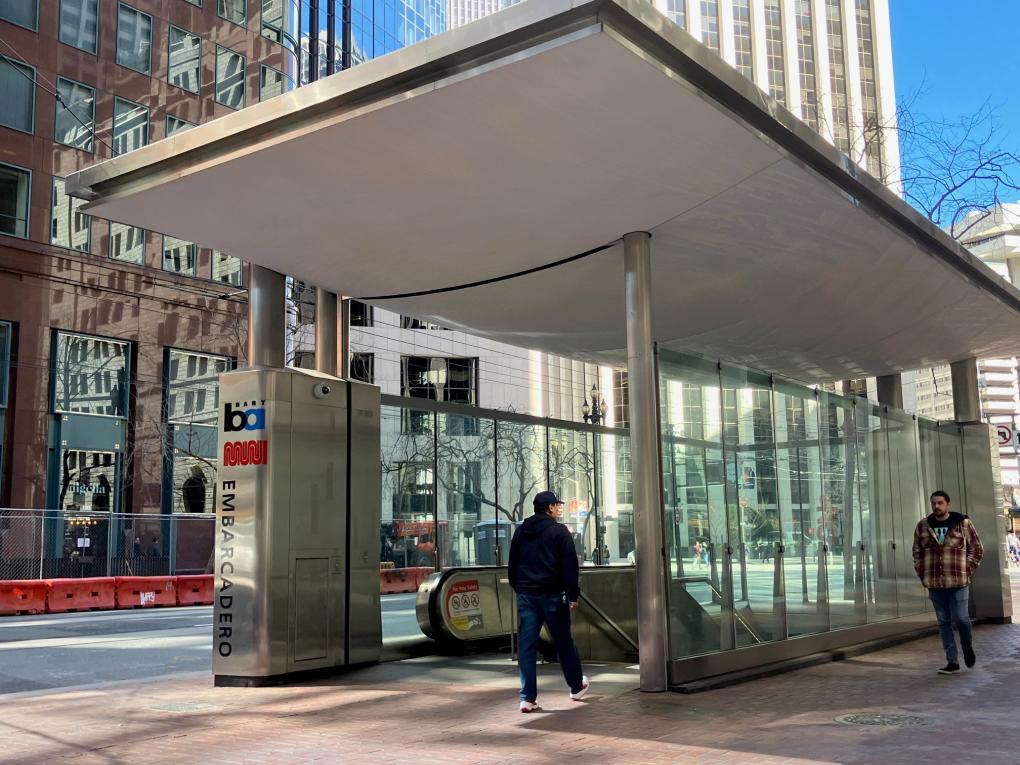
A photo of the new canopy at Embarcadero Station.
David Silva, Project Manager for the Market Street Canopies Project
"In addition to providing weather protection for patrons and escalators, the canopies assist with placemaking, providing easily recognizable entrances to the stations. They also feature real-time displays to provide patrons with train and bus schedule information as well as security features such as improved lighting, cameras, and grilles that secure the entrances at street level at night.
This project requires an enormous amount of coordination. I am very proud of how the entire project team has come together with the invaluable assistance of BART Government and Community Relations to keep the community, including neighboring businesses, rideshare companies, and other stakeholders informed about the project while working to understand and address their concerns."
Elliott Kolto, Principal Mechanical Engineer
"To date, the project has successfully completed the replacement of 17 escalators, with 24 remaining and three to six undergoing replacement at any given time. The new escalators are more modern and reliable with updated safety features, technology, and maintainability.
I am proud to be a part of this project and work with the team of engineers, maintenance, project management, and construction management, who are working so hard together to make this project successful and improve the customer experience."
Traction Power Substation Restoration and Construction
Traction power facilities take incoming power from PG&E and convert it to 1,000 Volts (V) Direct Current (DC) power for BART’s third-rail system. The facilities also monitor, regulate, and ensure safe distribution of power throughout the system. Two new power substations by Civic Center and Montgomery St. Stations will be coming online this year, and another substation east of the Transbay Tube is currently undergoing full renovation. BART is also upgrading and restoring substations, including the Oakland facility mentioned below.
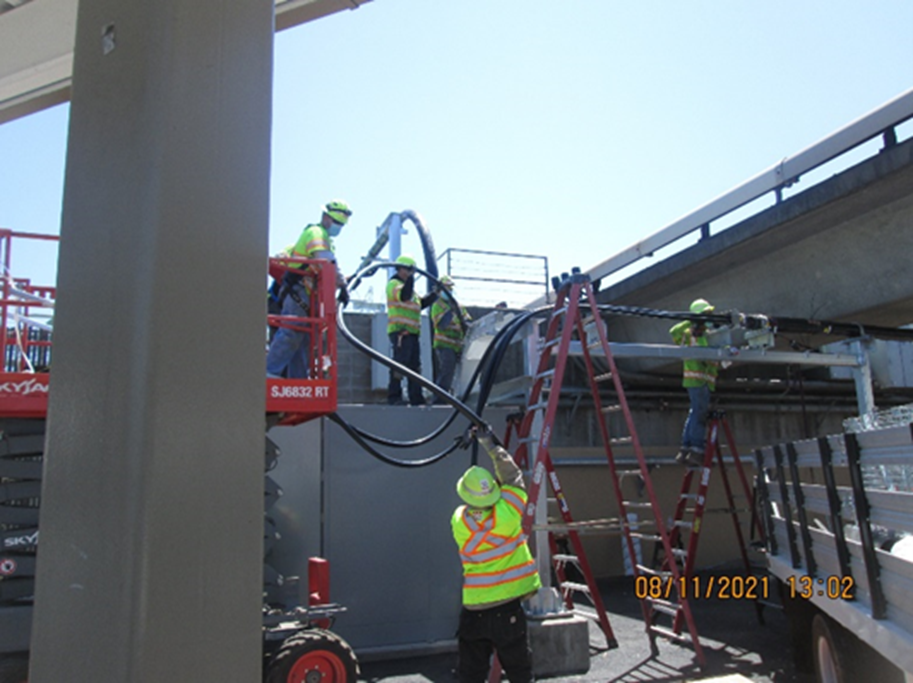
A photo of 34.5kV cable replacement and fiber optic installation between the Coliseum and Union City.
Gordon Wong, Principal Electrical Engineer
"The restoration of Downtown Oakland’s KTT substation, which failed last year after experiencing a fault, allows trains to operate at full speed, reducing delay and transfer times at MacArthur and 19th Street Station.
Having the substation back in service allows for redundancy in the network; there are now multiple substations able to supply power to the area, meaning customers will have a faster, more streamlined experience.
I am proud to work with the dedicated members of engineering and maintenance, who share the common goal of making sure BART is working for those who rely on us."
East Bay Rail Replacement
BART is replacing aging track, among other rebuilding projects that impact reliability, with funding from voter-approved bond Measure RR. The equipment being replaced is decades-old and has outlived its design life.
Engineers on the Yellow Line trackway between Pleasant Hill and Concord stations.
Girish Koli, Senior Manager of Engineering Programs
"I am proud to be part of this project as it improves safety for BART staff and reduces the maintenance burden. It will also enhance customer experience by providing patrons with a smoother and quieter ride.
This project was added to my portfolio last year, and I’ve been amazed to see how much hard work, coordination, and dedication many staff members have devoted to ensuring this is a successful project for BART."
Zeeshan Ali, Division Manager Traction Power Engineering (Interim)
"Traction Power Engineering recently completed several projects that significantly enhance the reliability and safety of BART’s electrical infrastructure. These upgrades offer a more dependable, faster, and safer transit experience for riders across the Bay Area.
I am proud of myself and my team for the contributions we’ve made and continue to make in connecting Bay Area communities."
BART PD hosts National Night Out Tuesday August 6th at Bay Fair and Millbrae stations
BART Police is participating in National Night Out, a community-building event held on the first Tuesday in August every year. This year, BART Police will host two events, and BART employees and their families are invited to join in. The events will be held at Bay Fair and Millbrae stations and will feature games, music, food, and opportunities to interact with BART Police officers and staff.
First introduced in 1984, National Night Out aims to enhance the relationship between neighbors and law enforcement. BART Police has participated in the campaign for over a decade.
Both events are from 4-7pm on Tuesday, August 6.
Bay Fair Station
15242 Hesperian Blvd, San Leandro
Hosted by Community Service Officer Susie Johnston
Millbrae Station
200 North Rollins Rd, Millbrae
Hosted by Crisis Intervention Specialist Remberto Calero
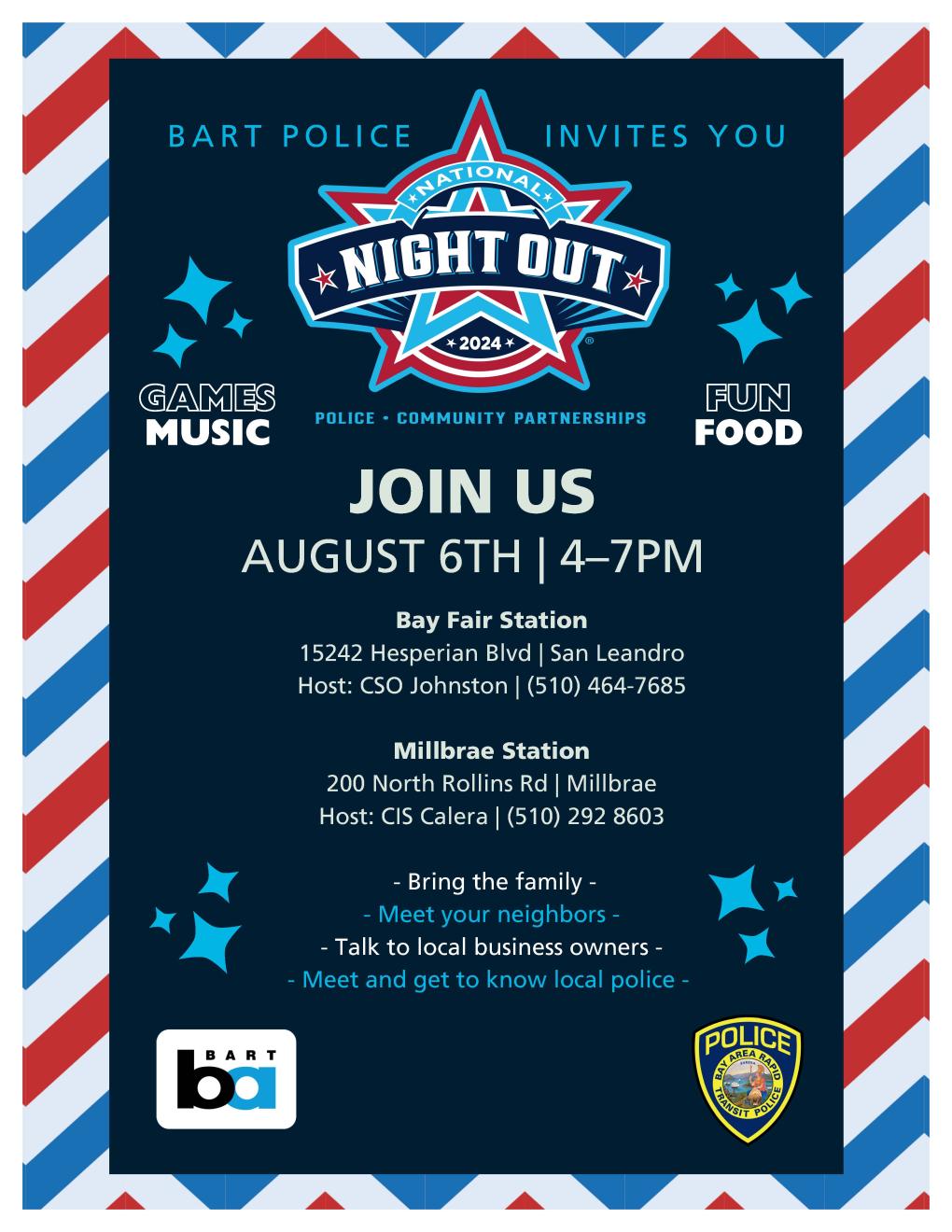
BART invites the public to “ride into history” at a legacy car retirement ceremony and final ride on 4/20/24
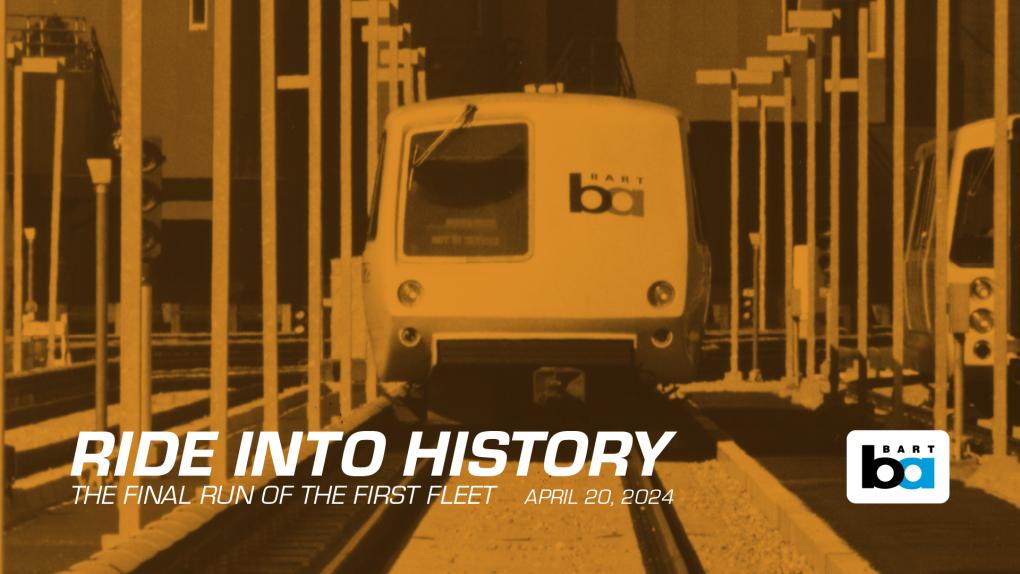
BART invites the public to join us to mark and celebrate the end of an era: the last run of BART’s legacy trains composed of rail cars that have been serving the Bay Area for more than half a century. We’re calling the event “Riding into History: Final Run of the First Fleet.”
The retirement ceremony will begin at 1pm on Saturday, April 20, 2024 at Oakland’s MacArthur Station with the and final dispatch of legacy trains happening after the speeches.
We recommend arriving around noon to enjoy the food trucks and activities we have planned.
The ceremony will take place in the plaza (free area) of the MacArthur station and will include food trucks (bayareamunchiez.com and noodle-cone.com), activity tables, a raffle for legacy car number plates, a pop-up merch store, and a stamp rally. Bring your stamp rally passport if you have one. Many of the groups who are repurposing old BART cars for new uses will be in attendance to share information about their projects.
Following the ceremony, the public will line up in the plaza and then board a legacy train and ride from MacArthur to Fremont Station, mirroring the initial service BART provided when it opened September 11, 1972. It’s a 45-minute trip that travels along approximately 24 miles of the original section of tracks. There will be more than one legacy train for the event. The trains will make all station stops and may turn around at Bay Fair depending on the number of attendees waiting to ride.
Every rider will need to pay for the ride with their Clipper card. The fare depends on where each rider is going after the ride.
“These train cars are part of the history of the Bay Area,” said Bob Powers, BART General Manager. “While we are excited to modernize the system, we recognize the profound cultural importance of these cars, and we want to celebrate their rich history and give them a proper send off.”
BART is able to completely retire the legacy fleet thanks to the success of the Fleet of the Future project. Seven hundred six new Fleet of the Future train cars are now certified for service – that’s 30 more cars than the legacy fleet inventory. A total of 720 new cars are on BART property as of April 1, 2024, and twenty cars a month are now being delivered to BART – twice as many as when the new cars first began to be delivered to the Hayward test track in 2016.
While the April 20 trip will be the final time the public will be able to ride the legacy fleet cars, it won’t be the last opportunity to spend time with the historic vehicles.
Three legacy cars will be headed to the Western Railway Museum in Suisun City for preservation and to provide a space for transit enthusiasts, researchers, and museum guests to enjoy and study for years to come. The three cars, including an iconic sloped-front A car, will be the only cars from the legacy fleet to be displayed at a museum.
A handful of other legacy cars will be transferred to those who successfully submitted proposals to repurpose the cars for short-term rentals, entertainment venues, and training facilities.
Most of the legacy cars, however, have been recycled, so April 20 is the last chance to ride these historic cars.
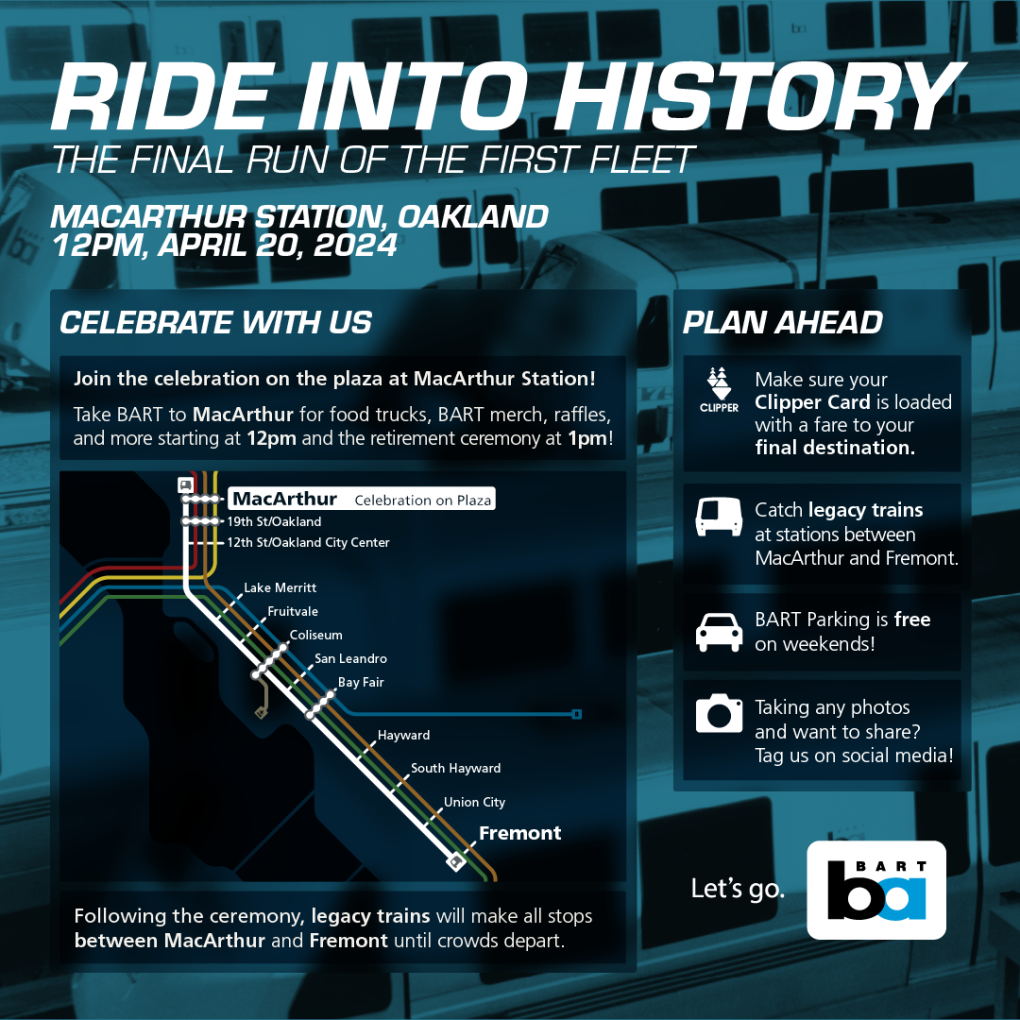
BART offers special early service with limited stops for first ever visit by ESPN’s College GameDay to Cal
BART is launching an early morning service blitz to help Cal fans get to the first ever appearance of ESPN’s College GameDay pregame show in Berkeley this Saturday, October 5. BART will offer five trains with limited stops before our regular Saturday service begins at 6am. The special early service will get fans to Downtown Berkeley Station around 5am, before the start of the pregame show.
The special early morning event trains will only serve the following stations: Daly City, 16th Street Mission, Powell, Pleasant Hill, Walnut Creek, Orinda, Fremont, Dublin/Pleasanton, Bay Fair, Fruitvale, El Cerrito del Norte, and MacArthur. These 12 stations in addition to Downtown Berkeley will be the only ones opened for the special early service. Full details on our added early morning service are available in the Trip Planner at BART.gov and on the official BART app.
The added early morning trains will go out of service once they complete their trips. Riders cannot board a train at Downtown Berkeley before regular Saturday service begins at 6am.
The game against Miami kicks off at 7:30pm. BART will run longer 8-car trains on the Red and Orange lines as well as add several event trains to its normal service that night to accommodate the anticipated crowds.
Special Service Details
*A northbound Red Line train will leave Daly City at 4:19am and will make stops at 16th Street Mission, Powell, and MacArthur before arriving at Downtown Berkeley Station at 4:55am.
*A southbound Orange Line train will leave El Cerrito del Norte at 4:47am and arrive at Downtown Berkeley Station at 4:55am.
*A northbound Orange Line train will leave Fremont at 4:13am and will make stops at Bay Fair, Fruitvale, and MacArthur before arriving at Downtown Berkeley at 4:55am.
*A westbound Blue Line train will depart Dublin/Pleasanton at 4:08am and stop at Bay Fair at 4:25am where riders can then transfer to the northbound Orange Line train to Downtown Berkeley at 4:25am.
*A southbound Yellow Line train will depart Pleasant Hill at 4:25am and make stops at Walnut Creek and Orinda before arriving at MacArthur Station at 4:45am where riders can transfer to the northbound Orange Line train to Downtown Berkeley at 4:50am.
Tips
BART parking is free on Saturdays. People driving to BART to take the early trains should park at one of the stations being served. There is no BART parking available at 16th Street Mission and Powell stations.
Once on the platform, the added trains will be labelled as: “Limited Stops to Downtown Berkeley.”
Load your Clipper card in advance with enough funds for the round trip.
If you don’t have a Clipper card, add one for free ($3 savings) to your phone’s wallet in advance and use Google Pay or Apple Pay.
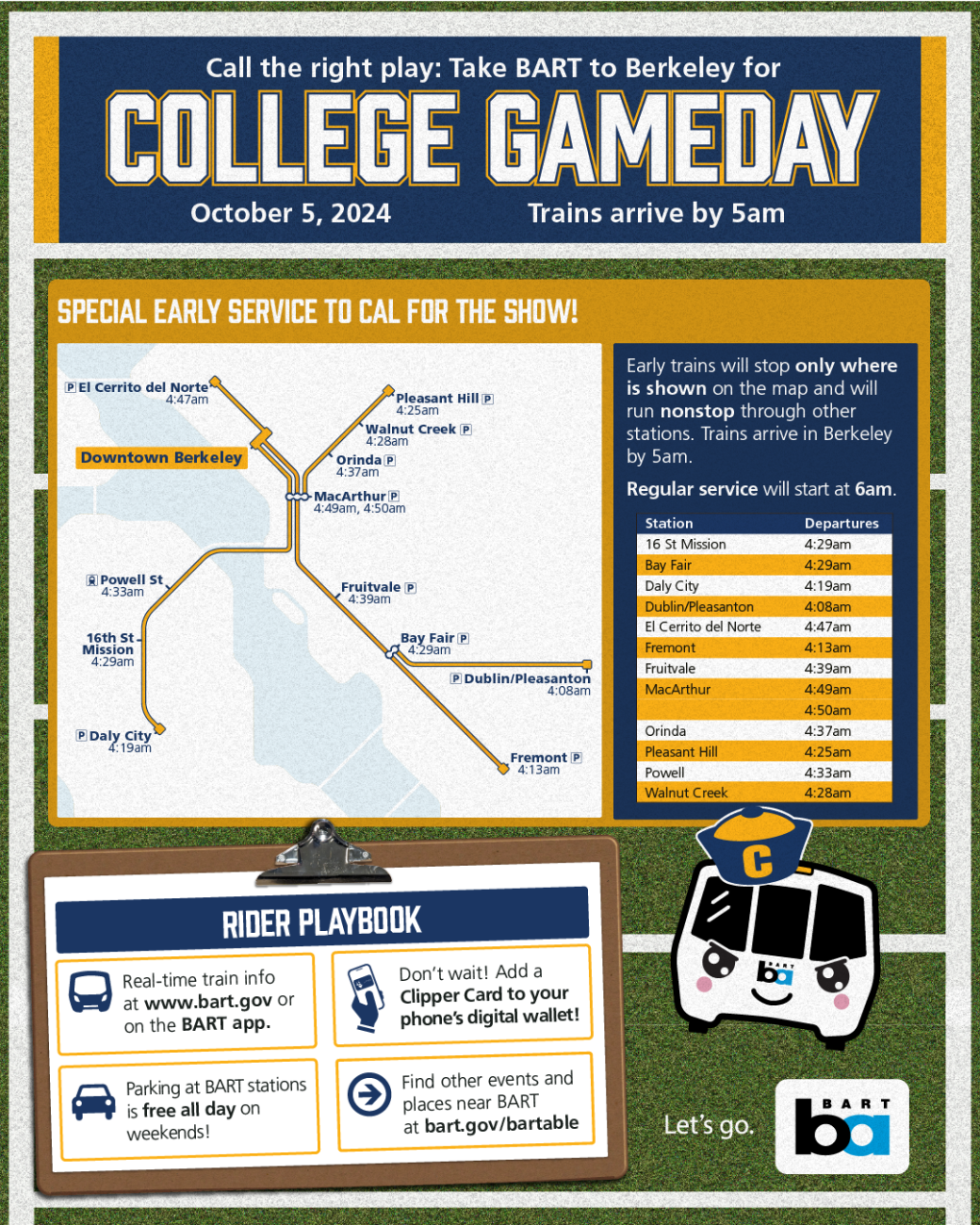
BART App to undergo planned maintenance on July 19, 2024 impacting some features including parking payment
On the evening of Friday, July 19, 2024, BART will perform planned maintenance on the official BART app starting at around 3pm and lasting several hours. During the maintenance, the BART Trip Planner, real time train departures, service alerts, and the fare calculator will continue to be available on the app. Parking payment features will not be available however parking is free after 3pm and on weekends and the maintenance will be complete in time for weekday riders. For those looking to reserve parking in advance during the maintenance window, they will get a prompt to try again on Saturday when the maintenance is complete. BART’s website for purchasing reserving parking will also be impacted during the same timeframe.
The profile and account setting features will also not be available on the app beginning at around 3pm on July 19, 2024, and lasting several hours.
Following the maintenance, app users will be prompted to update to the latest version of the app.
Podcast: How BART’s Art Program uplifts community, culture, and the economy – it's not just throwing murals on walls
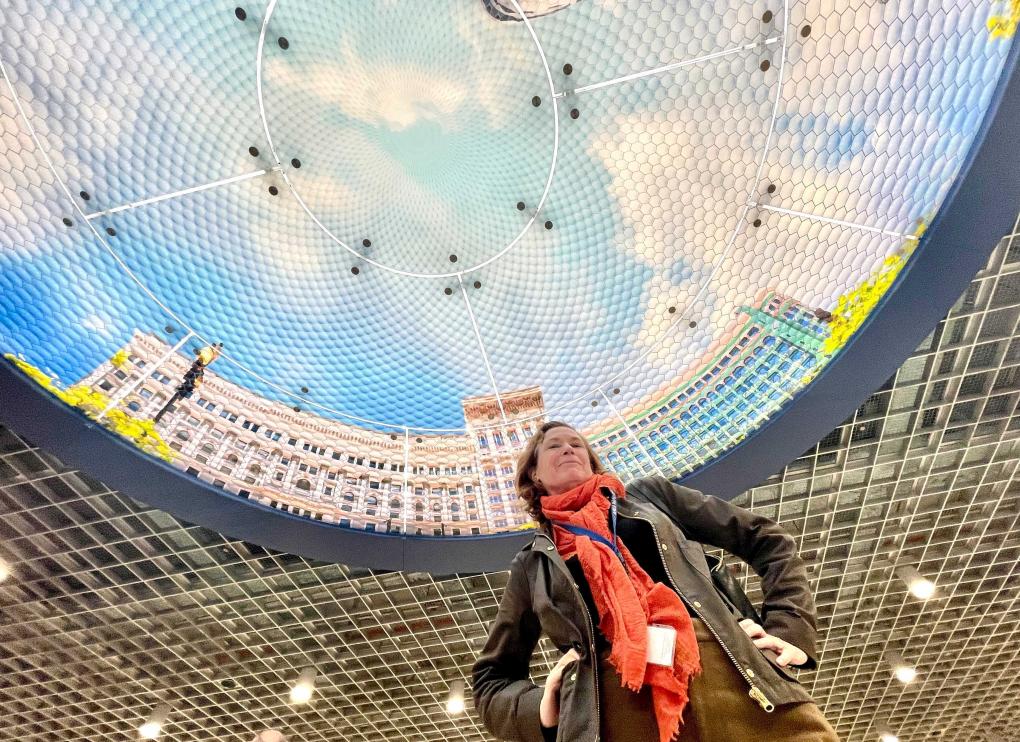
BART's innovative Art Program is making a huge difference in the transit experience of our riders. Since its inception in the 1960s, BART has prioritized bringing art and cultural experiences to stations. On our latest edition of “Hidden Tracks: Stories from BART,” BART Art Program Manager Jennifer Easton discusses the wide range of projects her one-woman department has undertaken – from murals and fashion shows to poetry contests and safety initiatives – and makes the case for the importance of weaving art and culture into the transit experience.
(TRANSCRIPT BELOW)
ROBERTSON: “Welcome to ‘Hidden Tracks: Stories from BART,’ I’m Michelle Robertson with BART Communications, and today I have the honor of being your host on this edition of Hidden Tracks. I'll be speaking with Jennifer Easton, BART's Art Program Manager. So, it's been a busy few years for Jennifer, who is the sole employee in the art program I'd like to point out. She has led a ton of projects that are hoping to make our stations more welcoming, safer, and let's face it, just nice places to be in while you're waiting for your train. In some ways, our stations are museums, not only for their architectural integrity, but also for many of the striking and historic artworks within and without. And we keep adding more. Jennifer, welcome to Hidden Track.
EASTON: Thank you, Michelle. I'm so happy to be here.
ROBERSTON: What prepared you for this role?
EASTON: I wish I could say I graduated nuclear scientist or something really tricky and try to dovetail from there. But I did start, my degree is in art history and museum studies, so, that's the road I went down. And I had been doing curatorial work for a number of years. I was a research assistant at LACMA (Los Angeles County Museum of Art) in Los Angeles and then I realized that all my colleagues were moving to very small towns and other places to kind of build their careers. And I was actually really interested in staying in Los Angeles at the time and I had early in college done some work around public art, really early on and kind of dovetailed back into that in Los Angeles and it just kind of went from there. It was a burgeoning field at the time and what was interesting to me and what's always been interesting is I'm a generalist in a lot of ways, right? I love just like the layers that public art is. I have to know construction. I have to know community engagement. I have to know artists. I have to know all these different cool things that I get to, so every day, I mean, maybe it's my ADHD, you know, it's like I get attached to 88 different projects.
I mean at a certain point I moved from Los Angeles to the Bay Area, and I went to tech and I was doing tech marketing, so I learned marketing when that kind of went downhill. I went into nonprofit management and I was doing PR and marketing and that and fundraising. So, I've learned all these crazy skills and then I was ultimately running the public art program for the City of San Jose, which is a pretty big program. Then this opened up and it was like my dream job, because I'd always been a BART girl and have loved transit, have used transit, and I always felt like the early BART program had art in it, but it never really advanced very far. Grace Crunican, the GM at the time, who had come from Seattle, had seen how positive that program was to the success of their transit system and brought it. We had always had somebody kind of babysitting art projects or doing some of the art projects, some of my colleagues when I started here had been doing like that San Francisco extension, there's art there, but it never really been focal. So, when they decided to do this, I was like, let me please let me and that's how I came to do it. I mean, it's really it is a field for people really interested in like a lot of different things, which is kind of exactly where my brain goes. So, it’s fun!

ROBERTSON: I want to talk about a project that's currently underway at Fruitvale Station that I think is indicative of a lot of the work that you do. You're working with BART's longtime community partner, the Unity Council, to create a street gallery at the station. That's what they're calling it and the Unity Council describes the project as a transformation of the station into a living canvas that reflects the rich culture and diversity of the Fruitvale community. Tell us more about that.
EASTON: So, I'll go back to Grace stating early one she wanted this art program and I think one of the things that she said to me early on and I will say our current GM, Robert Powers, is right on that page, too, is that our stations really need to be more reflective of our communities, and they need to be better partners with our communities, right? And it's not that just the person who drives in drops their car, comes back, drives away. But it's really like, how are we a better partner to our neighborhoods where we are? Because as we know, our history is not 100% grand in that, and I think we are still thinking about what does that look like? How can we be part of the, if it’s still people are still considering it healing or just like new direction, so how do we be part of that dialog? So, Unity Council, was a partner in the Oscar Grant mural and, that day, I think day two, I was called in and I was asked, can you work with Oscar Grant's family? They really want to do a mural at the Fruitvale Station to honor him. It's interesting because, then I was going out there and I had several people come up to me and, this is not too long after Oscar had been killed, and it's like, is this the station?
The people didn't really have a sense of the place. There were a lot of people visiting to kind of as part of their healing process, as part of their like learning about it. And so the notion of creating that mural became really important and I thought it was really, kudos to BART for stepping into that space, because I know this has happened in other transit agencies and I wouldn't say this always happens where they go in collaboration with the family. I mean, it's always a tense relationship, understandably. So, the Unity Council, because they are representatives of that neighborhood, very strong representatives of the Fruitvale, they came on as a partner to make sure that everybody felt comfortable. Well, not comfortable, but to make sure everybody was in dialog about, just that they were in support of the family, the mural being there at the station and helping to be in that dialog about how this could be very successful.
So, I really appreciated their voice at the table during that process. But as we were talking and as we were doing that project, the Unity Council and I were talking about these other columns, and they have new housing that they've been building there. So, really kind of start to make that feel more like their vision of the Fruitvale got put on hold. Everybody got busy and then post COVID a lot of neighborhoods have been, challenged, right? Safety, security, businesses closing, things like that and Fruitvale is one of our busiest stations. So, the conversation came back again, and the Unity Council said, we'll raise the money. I supported them on with some funds. But, as a percentage, hardly anything, just to get the project up and running and then they've hired already four amazing artists, including the artists who painted the Oscar Grant mural, Refa One, and we're painting the columns, and it just makes the station come alive because it came from a place of love for the community ,expression of the community and they see it just as like a gateway to all the other beauty that's in the Fruitvale. So, they're seeing the beauty of a place where other people might say, oh, this or that, but they're all in on making the Fruitvale a place for their community. So, it just that just felt like a win for BART as far as what Grace had laid out to me early on and what the community wants to see from BART as a partner.
ROBERSTON: This is a big question. Why does BART have an art program? And we've had one forever, like you said. Why did the founders make sure we had an art program, which was novel at the time? A lot of agencies didn't have art in the station. Why did they want us to have one and why do we need to continue funding this program, especially as we're in this fiscal crisis?
EASTON: It's a great and big question. The early stations were, their early thinking about the stations; if you look at them, the system was not designed by one architect. It was designed by many, many architects and I think the notion was to have that sense of uniqueness, that the system was not monolithic, that you had different experiences in different places.
I will say it was a little hodgepodge at first. A rumor I heard from the artist who's since passed away, who did the relief carvings in like Richmond and Lake Merritt and many other stations. He said, yeah, one of the guys came to this concrete conferences I was at in San Francisco and said, you need to work on our BART system? He said, okay.
ROBERTSON: A concrete conference?
EASTON: Right? However, there was an early arts committee with some very important art critics, curators, and artists on it who were, that's who were grabbing those early artists and looking at the diversity. I mean, they made sure they were from Contra Costa, Alameda, and San Francisco counties. And I think it was really, again, there was no plan to have art in all the stations, but they did want to have these moments, as we still say surprise and delight. They did want, art was really starting to be seen. Public art was starting to come into its own. It was still more that what is now called plop art. The grand sculpture by important artists in a plaza.
ROBERSTON: Did you say plop art?
EASTON: Drop it in one place to drop a big sculpture in a place. Plop it down.
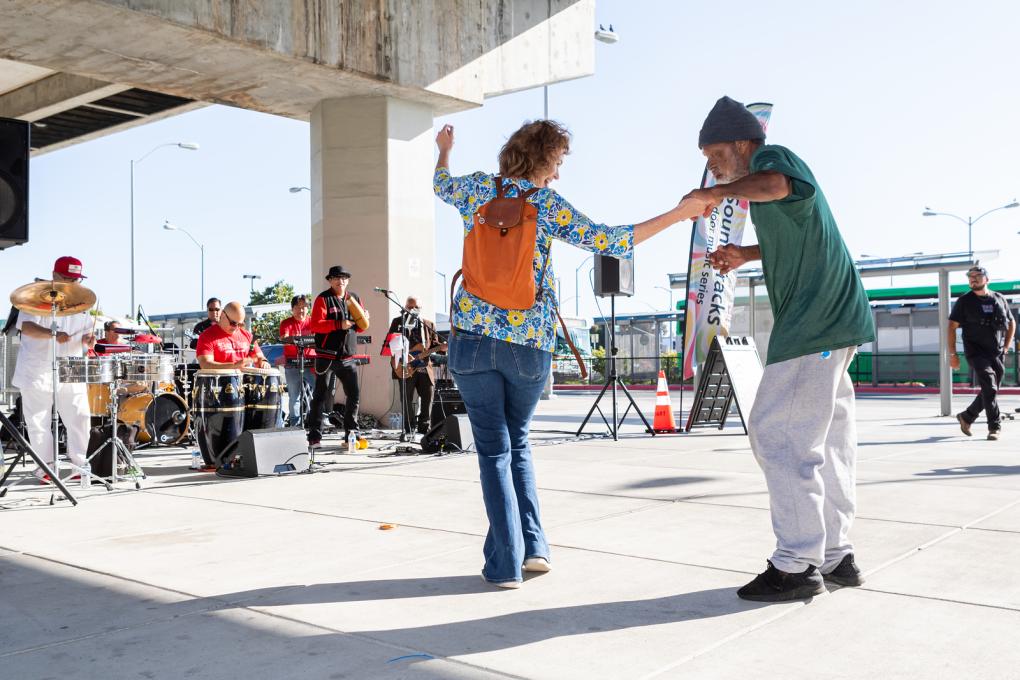
ROBERSTON: I love that. Why don't love that? Because it's very thoughtless.
EASTON: Well, sometimes it I mean, there are some places, like the Alexander Calder in Chicago that that become iconic, but for the most part, yes, it typically is really about the artist and not the place. But integrative art was happening and if you look back to like Paris and New York and some of these old systems, you see beautiful tile work, so you see these things you appreciate. And so, it was as we've gone along, I think we're just getting kind of following that breadcrumb trail. But as we've been talking about hopefully, it's kind of starting to make sense of why it makes sense to keep it going.
At the end of the day, there are a lot of hard decisions that will have to be made relative to the fiscal cliff, right? Where does the money come from? I will say that even though my program was authorized at 2% of construction costs, it has never worked on that. We've never implemented that. We are finding, like the key projects where it work and finding like what's the budget we can work within to make an impact.
So, we've been, I mean we the royal we, has been actually doing that since the beginning and it's never changed, and I think there are ways to do this efficiently. There's ways to do it boldly and broadly. New York, L.A., they have good sized programs. They deliver lots of amazing projects. We have never been that. So, how do we blend all those things together to create a result, you know what I mean instead of being formulaic?
ROBERTSON: Safety. I want to push this subject a little more. One of my profound experiences with art and safety has been in 19th Street Station, which is my home station. You were heavily involved in this modernization project. There were so many different pieces to it. We opened up the concourse. We tore down all these pillars and walls and opened up the line of sight. So now when I enter the station, I can see directly across it. So, there's no one lurking in dark corners. We replace the lighting with LED lights, more sustainable but also brighter. I especially want to point out that there are these incredible light boxes. Is that what they're called? They're almost like murals, but they're illuminated light box murals made by three local artists, and they're put in the stairwells. So, when I'm walking down the stairs to go catch my train to San Francisco, there's this lit up thing and again, it's less creepy because sometimes stairwells can be creepy as a woman. It's not only bright and adding light to the space, but it's so much fun. There's the Saunders Daisy, it's a bright yellow daisy, and it just perks me up.
EASTON: Yeah, when we did that project, when it was planned it was before COVID and the platforms were so crowded, particularly at rush hours, and people weren't using the stairs and in a number of stations. So, this is all part of the station modernization program that has since kind of been been modified. I won't say put on hold, but it's been modified and how we go about it, and I'm glad we got 19th Street done and Powell Street because they were two critical stations.
A lot of the station we were having to look at how do we get extra stairwell capacity in there for emergency egress and things like that. I came upon it and it was like glass in stairwells. However, it has been fine. People are not using them as bathrooms and people are being I mean we were careful how we installed them, how we created them. There's room for the mops to move around bikes, whatever. The glass can withstand certain things. But people are using the stairwells more. They are willing to do it, like you say. How do you create a sense of better sense of comfort in a place through the artwork?
We also have light boxes on the concourse level with changeable art and another thing I will be working on shortly is changing that out with either a local artist or local arts organization, or potentially images from our fashion show, because they're so fun to just bring that out. So, it's another way to kind of create that special uniqueness to a place with artwork. Then the whole theme of the artwork is, of the station is really about Uptown Oakland as being an arts district and the city wanting that as a kind of a thing. First Fridays, music venues, all that sort of stuff as more people are moving into the new apartments, making this a place where people want to be where, where it's exciting and as we're dealing with, the backlash against COVID and just like new workforce, the work-live relationships, things like that. I think we're really, that station is just like people come in, they're like, wow, it really does feel like a place that I feel pretty darn good about moving through and being in, you know? And it doesn't mean it's like perfect. It's not. People still like are people. They're still peeling some of the letters off of my project. But I just have to figure that out. It doesn't mean, it hasn't stopped us from being human and there's humans on the street. We're humans. Humans do human stuff. But I think just having us all feel like we want to be in the space makes us feel like generally safer in the space, because we're all kind of part of it. We're all using it. We're all engaging in it on our own volition and because it feels like a better space.
ROBERTSON: Those light boxes I haven't seen, like graffiti on them. They didn't get broken, no one’s smashed. I think we have a culture in America of not necessarily respecting our public spaces and if you're going into this dark box of a station that looks crappy, it makes you want to defile things because it already looks bad. But when you have art there, I don't think people are prone to like, messing with stuff.
EASTON: Right, that was, which New York mayor, I think it was Giuliani, who did that with the New York subway. Right, and if a train got tagged, it came off the line and BART does that too. If a train gets tagged right, it gets brought off the line.
So, we want to put our best foot forward for folks. We have a really zero tolerance policy for graffiti. We try and get rid of it as fast as possible because we've brought on more cleaners. We're thinking about our spaces, making sure they look as good as we can. However, that's just part and parcel of it, right? So, if you start with a bar that's bringing light levels up, all that sort of stuff, that's that part of the magic.
ROBERTSON: What BART stations would you consider destinations?
EASTON: Well, I mean, now, Fruitvale. So, that's an interesting question because for me, it's both the physical station, but also where the station is. I also think of it as an extension of the neighborhood. So, I love the Fruitvale neighborhood. There's so many great restaurants and it's just fun. 16th and 24th, I think are really fun stations for different reasons. Do you want to talk about?
ROBERTSON: I want to talk about 16th and 24th Street very briefly. Jennifer, or actually customer services got an email from a woman saying her mother is this famous public artist who created the tilescapes is what we're calling them, mosaics in 16th and 24th Street. And you don’t necessarily notice them because I used to live there, and I just moved through the station, but there's, like, these beautiful, honestly, murals on the concourse and on the platform. They were created by this woman, Janet Bennett. I want to point out, Janet has never really been recognized. She was tying these, you know, right before the station open. She was an OG BART artist. Meanwhile, there's these William Mitchell concrete reliefs at the station that are in every must-see historic art in the Bay Area. So, we got in touch with Janet Bennett, who is in her 90s and living in New York City and we got to have this amazing conversation with her and bring her story to light. She was interviewed on the news after we spoke to her. And my favorite part of that interview, god I love Janet, we got to get in touch with her. She said, I'm open to work if you're hiring, let me know. Somebody reached out, so we'll have to follow up and see if she actually did that.
But that's just another great example of how communications and the art program work together, because there's stories to tell about these stations and about the art in these stations and about what, people consider Janet's work decoration, but it is so not that.
EASTON: No, I mean, it really definitely had a consciousness behind it in the design. What we also learned is she created the mosaics at LAX, which were also very critical to changing those long hallways to make them more….
ROBERTSON: These are in the tunnels. The famous tunnels at LAX, and it was misattributed.
EASTON: Same thing. Misattributed. Her boss took credit because she did not. She had to move on to another job after she designed them, and the same year I think she moved on to a different job after. No, she was here through the end, I would take that back. Remember because there's a picture of her with them being installed and she worked with Heath Tiles another woman-owned business, Bay Area business. So, that's a really interesting discussion about how many of our artists also work with local artisans, right? Or local fabricators. So again, they're often seeking out the local, the bespoke, the custom and I often will connect them to local fabricators instead of ones from out of the area because we want to try and keep these dollars local as well. So, another kind of layer of that economic dialog too.
ROBERTSON: So, I don't think most of us know what goes into getting a public art project done. I certainly don't. I'm like, oh, they're like throwing it up there and it's the thing and wow, that was fast. I recently sat on a selection panel for an artist for BART police's new headquarters, which are going to be right in the heart of downtown Oakland at the 20th Street exit of 19th Street Station, like in front of the Paramount, yes, the Paramount. I mixed that up with the Fox sometimes and across from this gorgeous patina building where the coffee shop Tierra Mia is currently located. The old I Magnin, the department store, Yes. It’s a police station. We opened this conversation talking about Oscar Grant and talking about policing and how we're re-envisioning safety, that's been such a key piece of this conversation and BART police headquarters is going to be right there and on this panel, we are having all these conversations about what it means for this police department to be headquartered right there in this historic neighborhood with the history it has, and how do we make it a part of this place? And, you know, make it not just this dark, bureaucratic building, but a beautiful contribution to the space where if something does happen to you, you feel welcome to walk in there. So, this panel was so eye opening, and it just takes so much expertise and work and collaboration. Walk us through the process of ushering a public art project, into existence through the lens of our new, forthcoming headquarters for BART police.
EASTON: No project is rote. I think that's the whole point of thinking about each project uniquely, in its place, in its community and its function. So, that's where you start is like, what's the basis? What's the building? What’s the built environment. In this case it is to your point, it's an existing building that started out as a bank. It's a very 1980s building. Let's be honest. It's not the world's most attractive building and in our conversations, in our initial conversations and this is what's so funny about my job as I sit next to the person who does environmental clearance for BART and he was doing environmental clearance on this building, and he so he had been doing outreach to some of what we would call, communities of interest. He reached out to the Uptown Downtown Association and they're like, it was a Kaiser building up until recently. We bought it, the building from Kaiser. Their concern was the street presence of the building. When we were in conversation with the police department early on in the project, is this like they don't have a ton of money for this building, right? So again, it's like, what can the art do? It was really critical that we cannot drop something that feels like Fort Knox in the middle of downtown Oakland and expect to be welcome.
ROBERTSON: But you also have to balance that. It is a police station.
EASTON: It is a police station, right. So you have to harden the building and do all those fun things.
ROBERTSON: But what role does art play, it has so many different things it does?
EASTON: “So that's why we want to bring artists on early and so that's one of the things we try and do really often. So, when we are kind of formulating what the project is, it’s like when can when does the artist come in? I have some projects, I will be honest that I've brought the artists in and say, great, we're going to bring them early. They’re sitting on the shelf as we speak because BART brings projects to a certain point and depending on the finances or whatever, it could go on the shelf for a while. I mean, I was here six years before my first project finished. You know, my first construction project finished.
ROBERTSON: What was that project?
EASTON: I think it was El Cerrito del Norte, the new mosaics at El Cerrito del Norte, maybe five, but I think the six and then came Powell and the 19th, right? But those all were in process. They had just started when I started here. So, six years later. But this one, it was really critical because it is a design build project. Progressive design, even more aggressive that the artist is part of the design team. So, her voice, Vicki Scurry, she's going to be in that process when they're considering hardening, when they're considering reinforcing the parking lot. So, how do we do it?
She came and spent, she's from Seattle, she came and spent a week here after she was selected, by our committee of police officers, community members, artists, you know, arts advisors, yourself, the project manager to really get a bunch of different voices in there, to really think about how do we make this something that reflects what I heard from the community as far as making this a place that doesn't feel, like doesn't add to a negative sense of this group, it adds to a positive sense of history? And everybody knows it has to function, there has to be a way in for the police to park their cars or whatever. There has to be secured parking. We understand that there's also a new cafe opening across the street, so I think there's an expectation. It's like, oh great, more employees here. So how do we build on that positive stuff.
The police have been really great about this. Like, no, we don't want to have shields and badges and pledges and that. We want it to reflect our values, but we want to be a good community partner and the police, you remember they were saying that at the meeting is that they want to be a place that the community actually feels like is part of their community.
ROBERTSON: All right. Jennifer, this was such a lovely conversation. Do you have any final thoughts?
EASTON: We didn't talk a lot about the collection and what it means to maintain a collection and it is like maintaining buildings, right? BART has, for better or worse, a lot of times been hands off with the artwork because there hasn't been somebody in my position to kind of shepherd that along. So, it's just like, how do we bring recognition internally as an organization? And then because I've had people interview me, it's like, oh, this collection's amazing, and why don't you do a map? Because I really need to get out there and get some stuff cleaned, you know what I mean? So, it's just like, as a party of one. I'm so fortunate I now have somebody who's assisting me for a period of time. She's at San Francisco State in a graduate program, and she's really excited about collection management.
So, she's helping me be that part of my brain to kind of get the collection into our inventory system and things like that. But it is a critical, part of doing that putting it out there is making sure it looks great for years to come and that it generationally kind of continues on, and then it starts to be part of those layers of the story, of the history of BART, and that we save it and talking about our historic preservation, now that we're 50 years old, we have to have some of those conversations. How are we part of that conversation? And just like continuing to respect our system and make the spaces as amazing as possible and have the best system possible,
ROBERTSON: Jennifer, we're so lucky to have at BART. I am so lucky. Talk about surprise and delight, you surprise and delight me every day. Thank you for joining us for Hidden Tracks: stories from BART. You can listen to the podcast on SoundCloud, iTunes, Google Play, and of course on our website at BART.gov/podcasts. Now get out there and check out some BART art, please.”